Project Management Methodologies: A Business Report Analysis
VerifiedAdded on 2021/06/17
|18
|3906
|66
Report
AI Summary
This report analyzes and compares project management methodologies suitable for different business contexts. It begins by defining project management and outlining its key processes, including initiation, planning, execution, monitoring, and closure. The report then presents three case studies. Organization A, a high-tech manufacturing company, is recommended to use the PMBOK methodology for its expansion project in the Americas, due to its structured approach and familiarity among existing staff. Organization B, a small organization working with the European government, is advised to adopt the Prince2 methodology to mitigate financial risks and ensure controlled project implementation. The report discusses the advantages, disadvantages, and assumptions associated with each methodology, providing a comprehensive overview of their suitability for various project types. The report also includes visual aids like figures and diagrams to support the analysis.
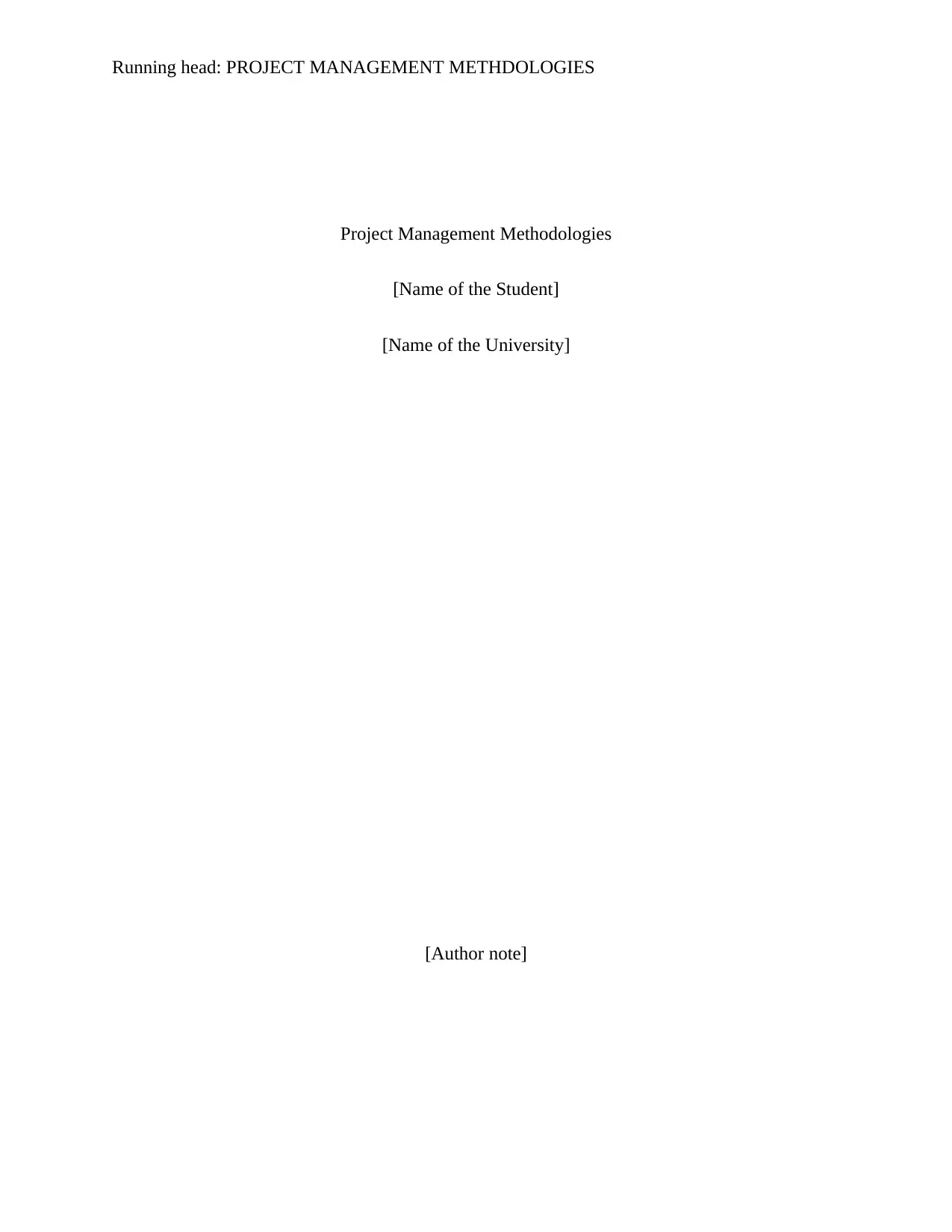
Running head: PROJECT MANAGEMENT METHDOLOGIES
Project Management Methodologies
[Name of the Student]
[Name of the University]
[Author note]
Project Management Methodologies
[Name of the Student]
[Name of the University]
[Author note]
Paraphrase This Document
Need a fresh take? Get an instant paraphrase of this document with our AI Paraphraser
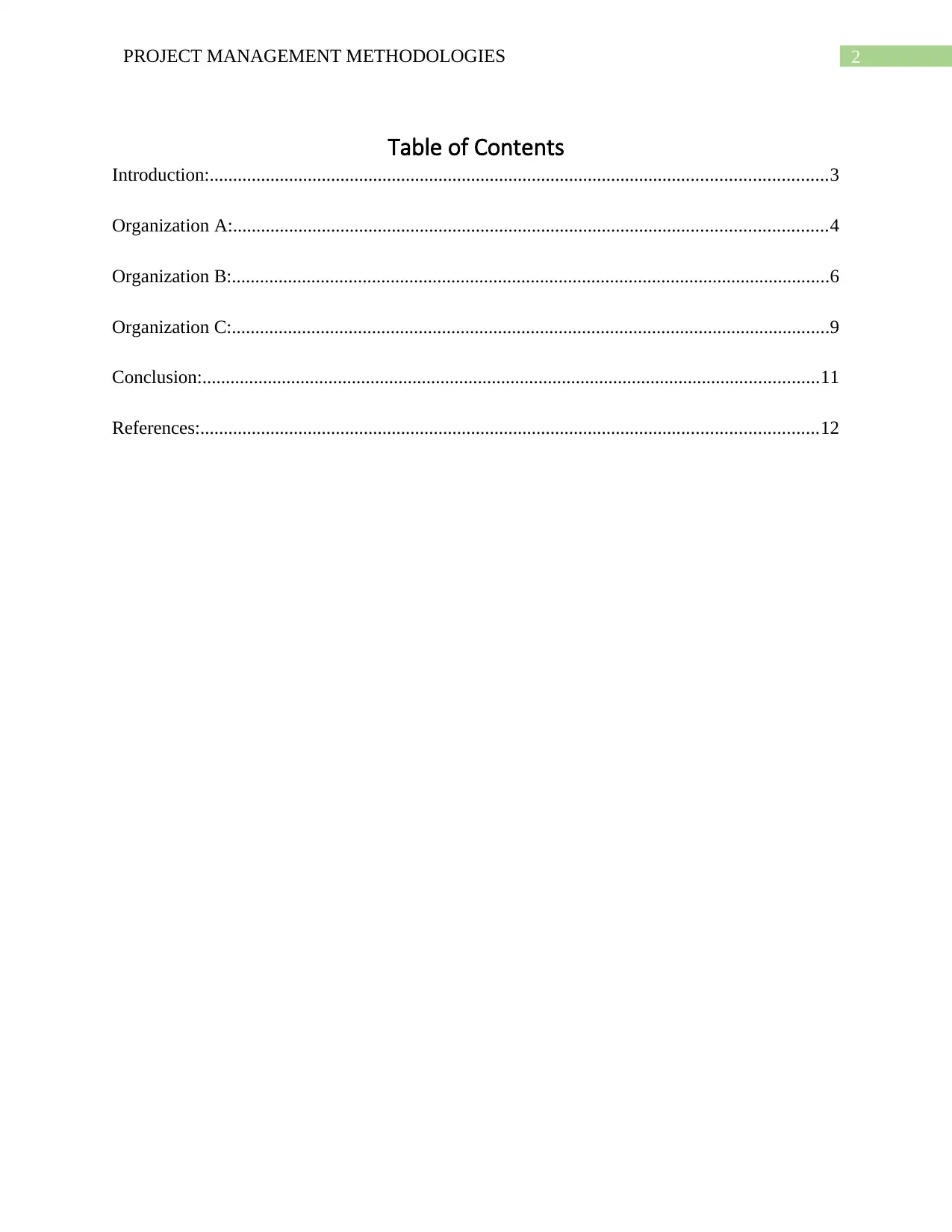
2PROJECT MANAGEMENT METHODOLOGIES
Table of Contents
Introduction:....................................................................................................................................3
Organization A:...............................................................................................................................4
Organization B:................................................................................................................................6
Organization C:................................................................................................................................9
Conclusion:....................................................................................................................................11
References:....................................................................................................................................12
Table of Contents
Introduction:....................................................................................................................................3
Organization A:...............................................................................................................................4
Organization B:................................................................................................................................6
Organization C:................................................................................................................................9
Conclusion:....................................................................................................................................11
References:....................................................................................................................................12
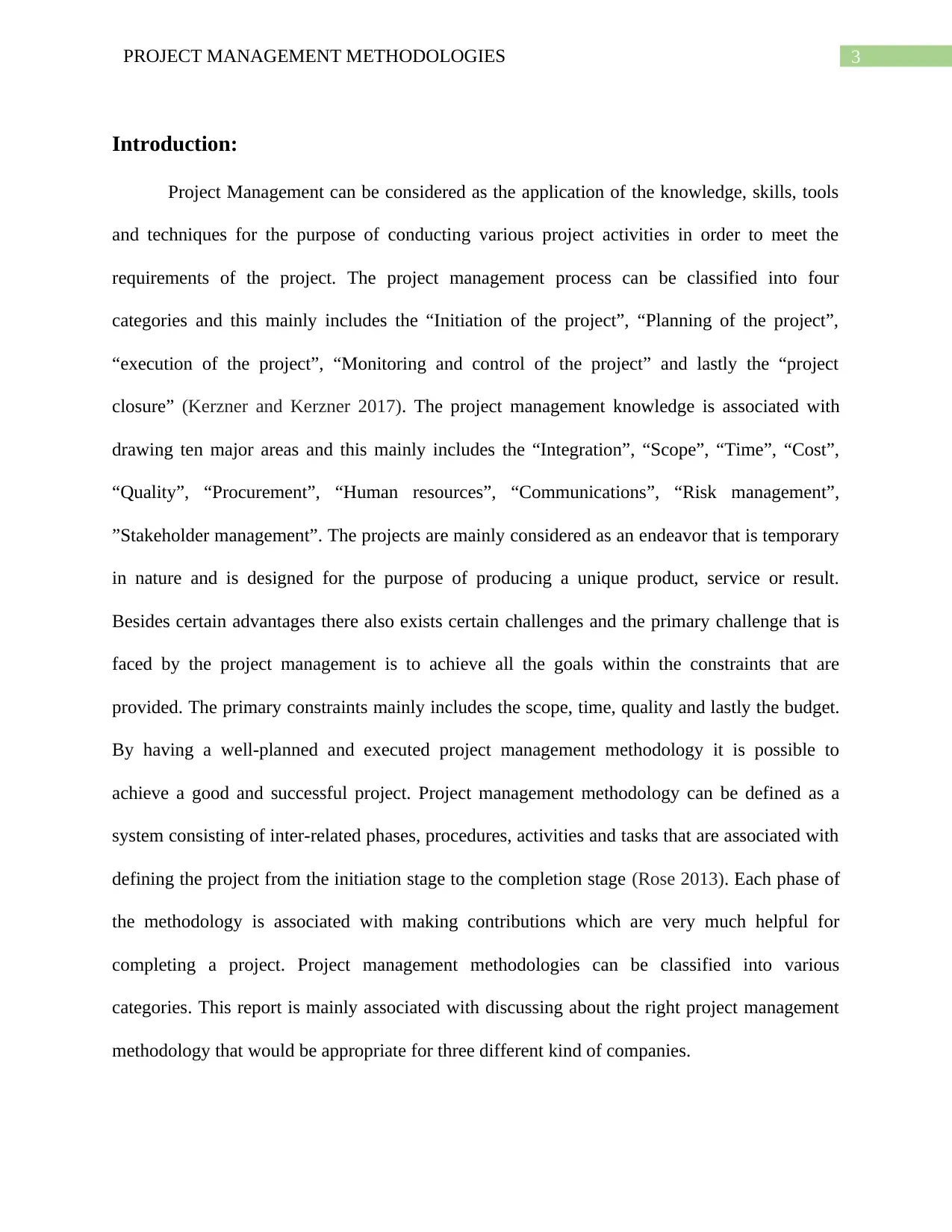
3PROJECT MANAGEMENT METHODOLOGIES
Introduction:
Project Management can be considered as the application of the knowledge, skills, tools
and techniques for the purpose of conducting various project activities in order to meet the
requirements of the project. The project management process can be classified into four
categories and this mainly includes the “Initiation of the project”, “Planning of the project”,
“execution of the project”, “Monitoring and control of the project” and lastly the “project
closure” (Kerzner and Kerzner 2017). The project management knowledge is associated with
drawing ten major areas and this mainly includes the “Integration”, “Scope”, “Time”, “Cost”,
“Quality”, “Procurement”, “Human resources”, “Communications”, “Risk management”,
”Stakeholder management”. The projects are mainly considered as an endeavor that is temporary
in nature and is designed for the purpose of producing a unique product, service or result.
Besides certain advantages there also exists certain challenges and the primary challenge that is
faced by the project management is to achieve all the goals within the constraints that are
provided. The primary constraints mainly includes the scope, time, quality and lastly the budget.
By having a well-planned and executed project management methodology it is possible to
achieve a good and successful project. Project management methodology can be defined as a
system consisting of inter-related phases, procedures, activities and tasks that are associated with
defining the project from the initiation stage to the completion stage (Rose 2013). Each phase of
the methodology is associated with making contributions which are very much helpful for
completing a project. Project management methodologies can be classified into various
categories. This report is mainly associated with discussing about the right project management
methodology that would be appropriate for three different kind of companies.
Introduction:
Project Management can be considered as the application of the knowledge, skills, tools
and techniques for the purpose of conducting various project activities in order to meet the
requirements of the project. The project management process can be classified into four
categories and this mainly includes the “Initiation of the project”, “Planning of the project”,
“execution of the project”, “Monitoring and control of the project” and lastly the “project
closure” (Kerzner and Kerzner 2017). The project management knowledge is associated with
drawing ten major areas and this mainly includes the “Integration”, “Scope”, “Time”, “Cost”,
“Quality”, “Procurement”, “Human resources”, “Communications”, “Risk management”,
”Stakeholder management”. The projects are mainly considered as an endeavor that is temporary
in nature and is designed for the purpose of producing a unique product, service or result.
Besides certain advantages there also exists certain challenges and the primary challenge that is
faced by the project management is to achieve all the goals within the constraints that are
provided. The primary constraints mainly includes the scope, time, quality and lastly the budget.
By having a well-planned and executed project management methodology it is possible to
achieve a good and successful project. Project management methodology can be defined as a
system consisting of inter-related phases, procedures, activities and tasks that are associated with
defining the project from the initiation stage to the completion stage (Rose 2013). Each phase of
the methodology is associated with making contributions which are very much helpful for
completing a project. Project management methodologies can be classified into various
categories. This report is mainly associated with discussing about the right project management
methodology that would be appropriate for three different kind of companies.
⊘ This is a preview!⊘
Do you want full access?
Subscribe today to unlock all pages.

Trusted by 1+ million students worldwide
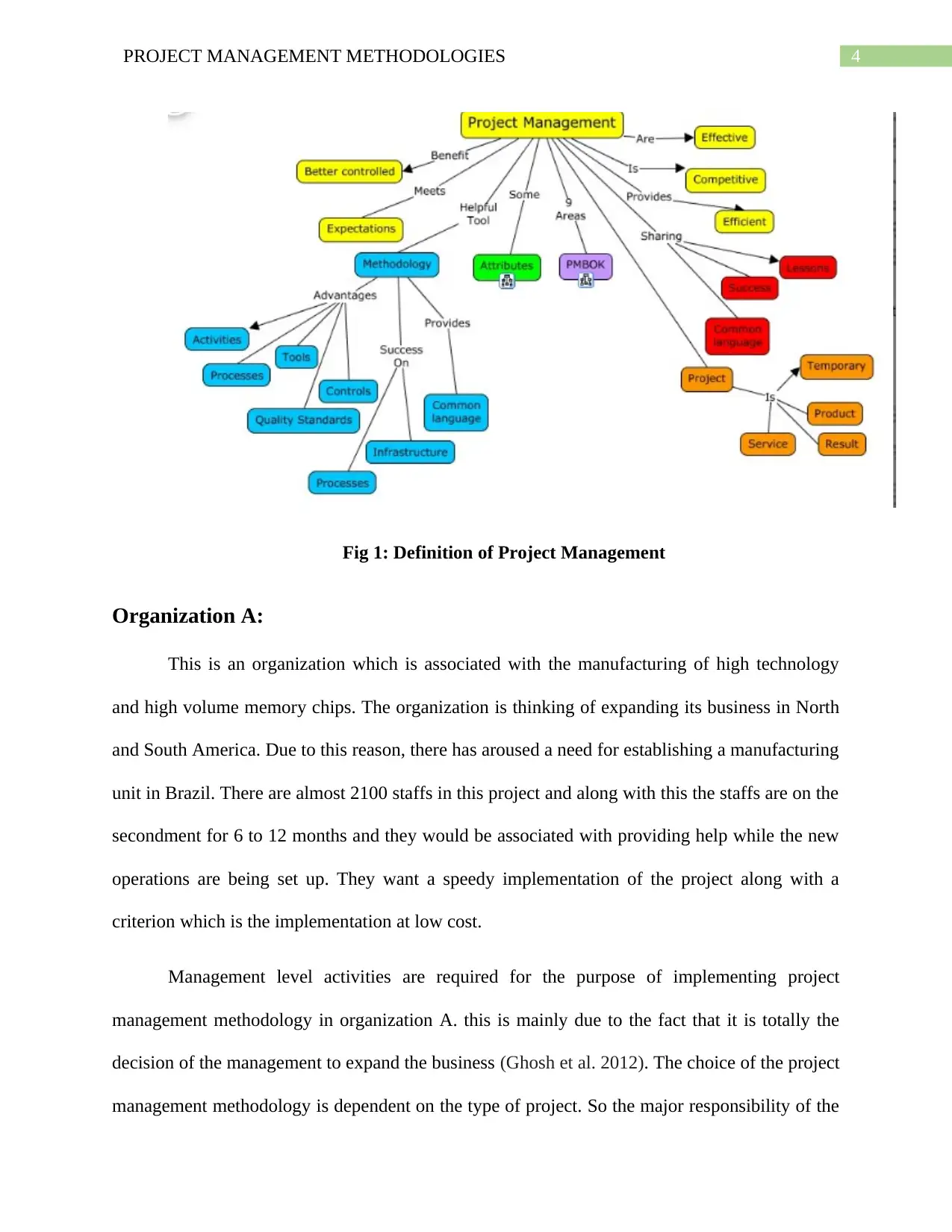
4PROJECT MANAGEMENT METHODOLOGIES
Fig 1: Definition of Project Management
Organization A:
This is an organization which is associated with the manufacturing of high technology
and high volume memory chips. The organization is thinking of expanding its business in North
and South America. Due to this reason, there has aroused a need for establishing a manufacturing
unit in Brazil. There are almost 2100 staffs in this project and along with this the staffs are on the
secondment for 6 to 12 months and they would be associated with providing help while the new
operations are being set up. They want a speedy implementation of the project along with a
criterion which is the implementation at low cost.
Management level activities are required for the purpose of implementing project
management methodology in organization A. this is mainly due to the fact that it is totally the
decision of the management to expand the business (Ghosh et al. 2012). The choice of the project
management methodology is dependent on the type of project. So the major responsibility of the
Fig 1: Definition of Project Management
Organization A:
This is an organization which is associated with the manufacturing of high technology
and high volume memory chips. The organization is thinking of expanding its business in North
and South America. Due to this reason, there has aroused a need for establishing a manufacturing
unit in Brazil. There are almost 2100 staffs in this project and along with this the staffs are on the
secondment for 6 to 12 months and they would be associated with providing help while the new
operations are being set up. They want a speedy implementation of the project along with a
criterion which is the implementation at low cost.
Management level activities are required for the purpose of implementing project
management methodology in organization A. this is mainly due to the fact that it is totally the
decision of the management to expand the business (Ghosh et al. 2012). The choice of the project
management methodology is dependent on the type of project. So the major responsibility of the
Paraphrase This Document
Need a fresh take? Get an instant paraphrase of this document with our AI Paraphraser
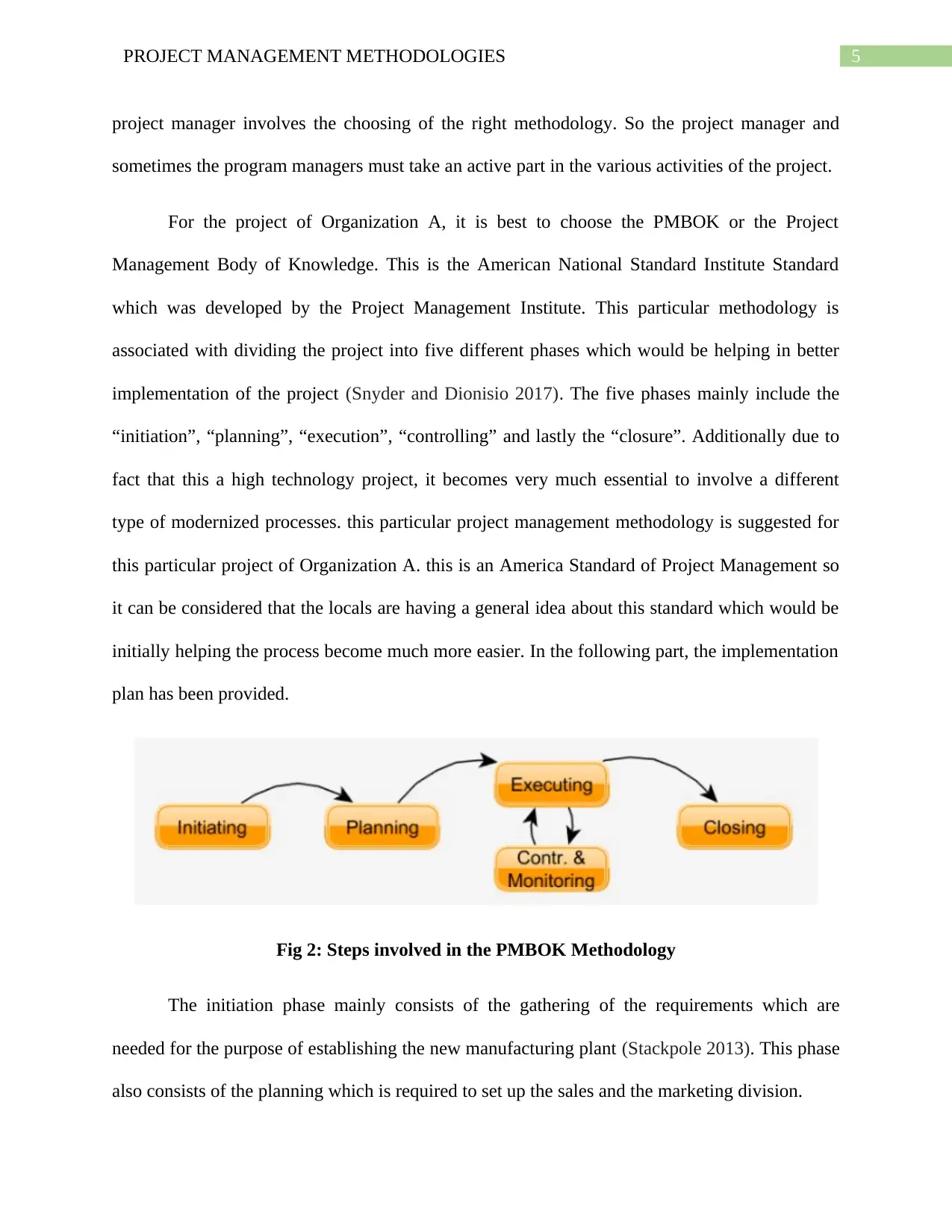
5PROJECT MANAGEMENT METHODOLOGIES
project manager involves the choosing of the right methodology. So the project manager and
sometimes the program managers must take an active part in the various activities of the project.
For the project of Organization A, it is best to choose the PMBOK or the Project
Management Body of Knowledge. This is the American National Standard Institute Standard
which was developed by the Project Management Institute. This particular methodology is
associated with dividing the project into five different phases which would be helping in better
implementation of the project (Snyder and Dionisio 2017). The five phases mainly include the
“initiation”, “planning”, “execution”, “controlling” and lastly the “closure”. Additionally due to
fact that this a high technology project, it becomes very much essential to involve a different
type of modernized processes. this particular project management methodology is suggested for
this particular project of Organization A. this is an America Standard of Project Management so
it can be considered that the locals are having a general idea about this standard which would be
initially helping the process become much more easier. In the following part, the implementation
plan has been provided.
Fig 2: Steps involved in the PMBOK Methodology
The initiation phase mainly consists of the gathering of the requirements which are
needed for the purpose of establishing the new manufacturing plant (Stackpole 2013). This phase
also consists of the planning which is required to set up the sales and the marketing division.
project manager involves the choosing of the right methodology. So the project manager and
sometimes the program managers must take an active part in the various activities of the project.
For the project of Organization A, it is best to choose the PMBOK or the Project
Management Body of Knowledge. This is the American National Standard Institute Standard
which was developed by the Project Management Institute. This particular methodology is
associated with dividing the project into five different phases which would be helping in better
implementation of the project (Snyder and Dionisio 2017). The five phases mainly include the
“initiation”, “planning”, “execution”, “controlling” and lastly the “closure”. Additionally due to
fact that this a high technology project, it becomes very much essential to involve a different
type of modernized processes. this particular project management methodology is suggested for
this particular project of Organization A. this is an America Standard of Project Management so
it can be considered that the locals are having a general idea about this standard which would be
initially helping the process become much more easier. In the following part, the implementation
plan has been provided.
Fig 2: Steps involved in the PMBOK Methodology
The initiation phase mainly consists of the gathering of the requirements which are
needed for the purpose of establishing the new manufacturing plant (Stackpole 2013). This phase
also consists of the planning which is required to set up the sales and the marketing division.
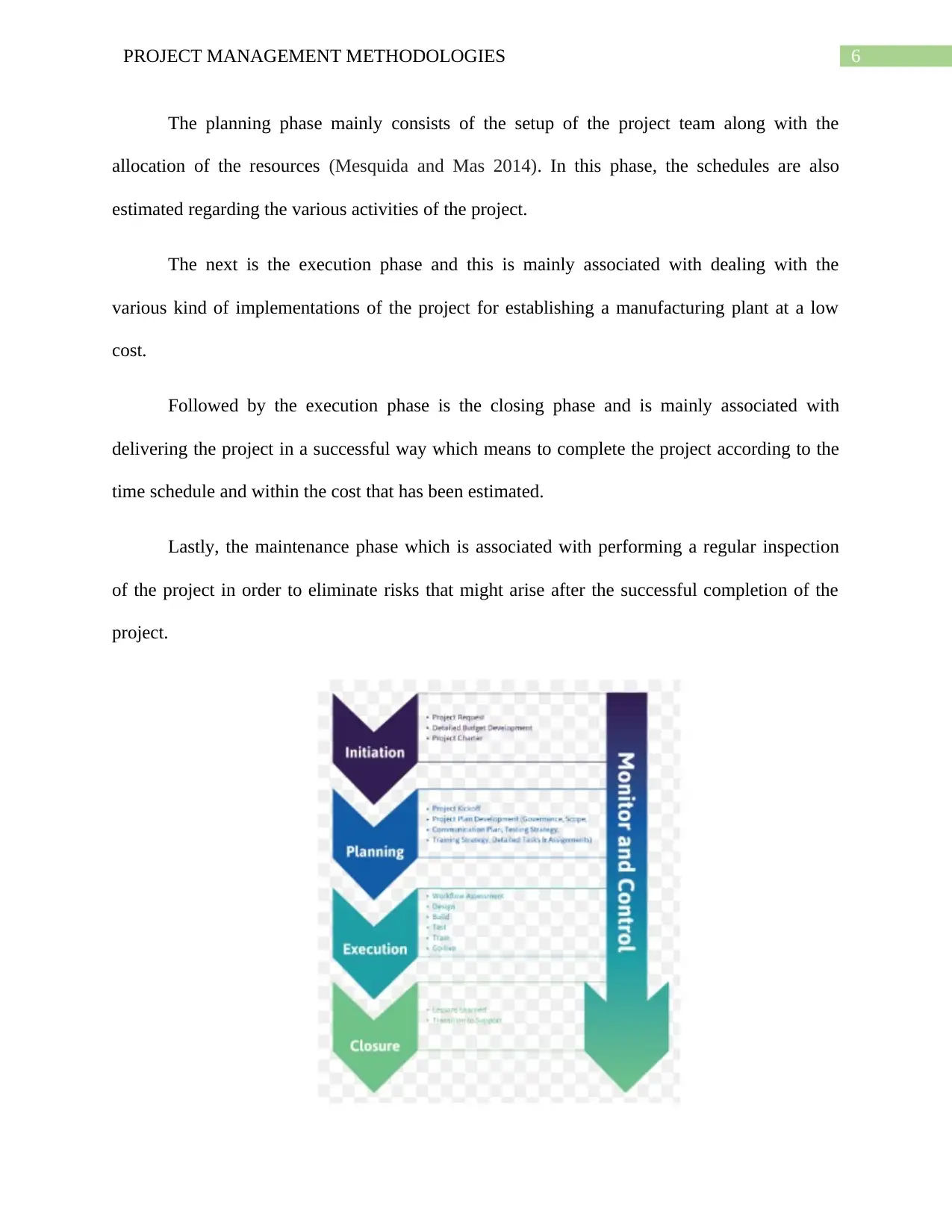
6PROJECT MANAGEMENT METHODOLOGIES
The planning phase mainly consists of the setup of the project team along with the
allocation of the resources (Mesquida and Mas 2014). In this phase, the schedules are also
estimated regarding the various activities of the project.
The next is the execution phase and this is mainly associated with dealing with the
various kind of implementations of the project for establishing a manufacturing plant at a low
cost.
Followed by the execution phase is the closing phase and is mainly associated with
delivering the project in a successful way which means to complete the project according to the
time schedule and within the cost that has been estimated.
Lastly, the maintenance phase which is associated with performing a regular inspection
of the project in order to eliminate risks that might arise after the successful completion of the
project.
The planning phase mainly consists of the setup of the project team along with the
allocation of the resources (Mesquida and Mas 2014). In this phase, the schedules are also
estimated regarding the various activities of the project.
The next is the execution phase and this is mainly associated with dealing with the
various kind of implementations of the project for establishing a manufacturing plant at a low
cost.
Followed by the execution phase is the closing phase and is mainly associated with
delivering the project in a successful way which means to complete the project according to the
time schedule and within the cost that has been estimated.
Lastly, the maintenance phase which is associated with performing a regular inspection
of the project in order to eliminate risks that might arise after the successful completion of the
project.
⊘ This is a preview!⊘
Do you want full access?
Subscribe today to unlock all pages.

Trusted by 1+ million students worldwide
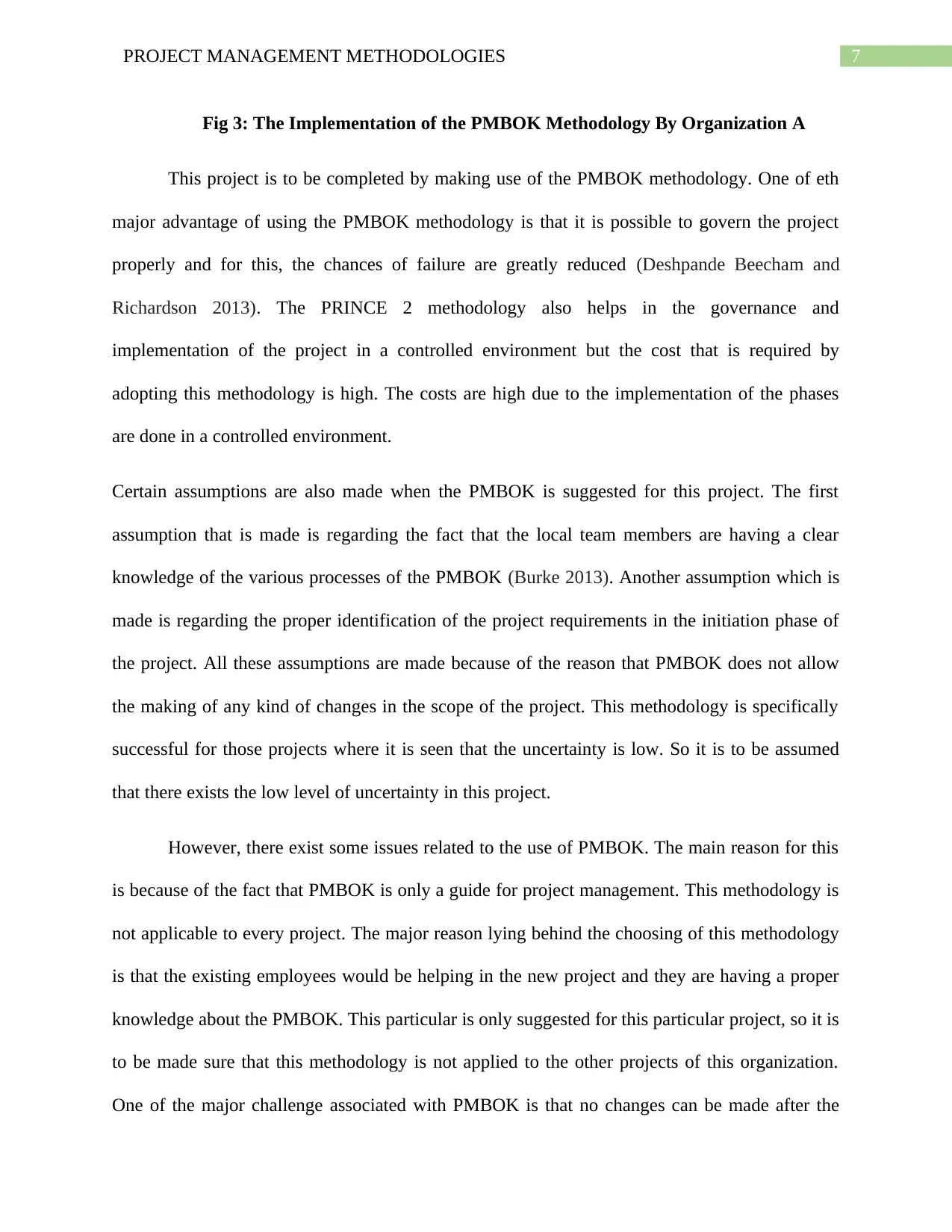
7PROJECT MANAGEMENT METHODOLOGIES
Fig 3: The Implementation of the PMBOK Methodology By Organization A
This project is to be completed by making use of the PMBOK methodology. One of eth
major advantage of using the PMBOK methodology is that it is possible to govern the project
properly and for this, the chances of failure are greatly reduced (Deshpande Beecham and
Richardson 2013). The PRINCE 2 methodology also helps in the governance and
implementation of the project in a controlled environment but the cost that is required by
adopting this methodology is high. The costs are high due to the implementation of the phases
are done in a controlled environment.
Certain assumptions are also made when the PMBOK is suggested for this project. The first
assumption that is made is regarding the fact that the local team members are having a clear
knowledge of the various processes of the PMBOK (Burke 2013). Another assumption which is
made is regarding the proper identification of the project requirements in the initiation phase of
the project. All these assumptions are made because of the reason that PMBOK does not allow
the making of any kind of changes in the scope of the project. This methodology is specifically
successful for those projects where it is seen that the uncertainty is low. So it is to be assumed
that there exists the low level of uncertainty in this project.
However, there exist some issues related to the use of PMBOK. The main reason for this
is because of the fact that PMBOK is only a guide for project management. This methodology is
not applicable to every project. The major reason lying behind the choosing of this methodology
is that the existing employees would be helping in the new project and they are having a proper
knowledge about the PMBOK. This particular is only suggested for this particular project, so it is
to be made sure that this methodology is not applied to the other projects of this organization.
One of the major challenge associated with PMBOK is that no changes can be made after the
Fig 3: The Implementation of the PMBOK Methodology By Organization A
This project is to be completed by making use of the PMBOK methodology. One of eth
major advantage of using the PMBOK methodology is that it is possible to govern the project
properly and for this, the chances of failure are greatly reduced (Deshpande Beecham and
Richardson 2013). The PRINCE 2 methodology also helps in the governance and
implementation of the project in a controlled environment but the cost that is required by
adopting this methodology is high. The costs are high due to the implementation of the phases
are done in a controlled environment.
Certain assumptions are also made when the PMBOK is suggested for this project. The first
assumption that is made is regarding the fact that the local team members are having a clear
knowledge of the various processes of the PMBOK (Burke 2013). Another assumption which is
made is regarding the proper identification of the project requirements in the initiation phase of
the project. All these assumptions are made because of the reason that PMBOK does not allow
the making of any kind of changes in the scope of the project. This methodology is specifically
successful for those projects where it is seen that the uncertainty is low. So it is to be assumed
that there exists the low level of uncertainty in this project.
However, there exist some issues related to the use of PMBOK. The main reason for this
is because of the fact that PMBOK is only a guide for project management. This methodology is
not applicable to every project. The major reason lying behind the choosing of this methodology
is that the existing employees would be helping in the new project and they are having a proper
knowledge about the PMBOK. This particular is only suggested for this particular project, so it is
to be made sure that this methodology is not applied to the other projects of this organization.
One of the major challenge associated with PMBOK is that no changes can be made after the
Paraphrase This Document
Need a fresh take? Get an instant paraphrase of this document with our AI Paraphraser
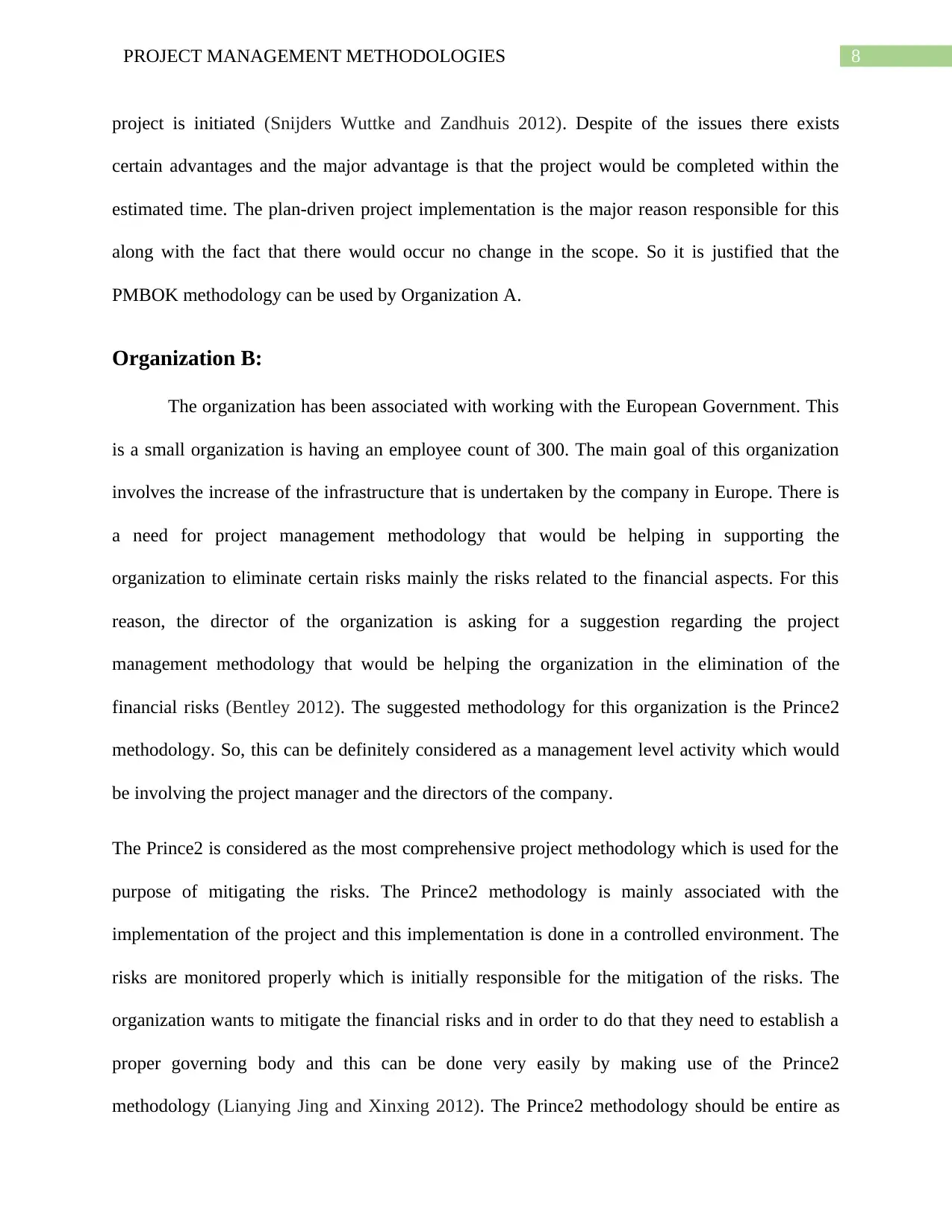
8PROJECT MANAGEMENT METHODOLOGIES
project is initiated (Snijders Wuttke and Zandhuis 2012). Despite of the issues there exists
certain advantages and the major advantage is that the project would be completed within the
estimated time. The plan-driven project implementation is the major reason responsible for this
along with the fact that there would occur no change in the scope. So it is justified that the
PMBOK methodology can be used by Organization A.
Organization B:
The organization has been associated with working with the European Government. This
is a small organization is having an employee count of 300. The main goal of this organization
involves the increase of the infrastructure that is undertaken by the company in Europe. There is
a need for project management methodology that would be helping in supporting the
organization to eliminate certain risks mainly the risks related to the financial aspects. For this
reason, the director of the organization is asking for a suggestion regarding the project
management methodology that would be helping the organization in the elimination of the
financial risks (Bentley 2012). The suggested methodology for this organization is the Prince2
methodology. So, this can be definitely considered as a management level activity which would
be involving the project manager and the directors of the company.
The Prince2 is considered as the most comprehensive project methodology which is used for the
purpose of mitigating the risks. The Prince2 methodology is mainly associated with the
implementation of the project and this implementation is done in a controlled environment. The
risks are monitored properly which is initially responsible for the mitigation of the risks. The
organization wants to mitigate the financial risks and in order to do that they need to establish a
proper governing body and this can be done very easily by making use of the Prince2
methodology (Lianying Jing and Xinxing 2012). The Prince2 methodology should be entire as
project is initiated (Snijders Wuttke and Zandhuis 2012). Despite of the issues there exists
certain advantages and the major advantage is that the project would be completed within the
estimated time. The plan-driven project implementation is the major reason responsible for this
along with the fact that there would occur no change in the scope. So it is justified that the
PMBOK methodology can be used by Organization A.
Organization B:
The organization has been associated with working with the European Government. This
is a small organization is having an employee count of 300. The main goal of this organization
involves the increase of the infrastructure that is undertaken by the company in Europe. There is
a need for project management methodology that would be helping in supporting the
organization to eliminate certain risks mainly the risks related to the financial aspects. For this
reason, the director of the organization is asking for a suggestion regarding the project
management methodology that would be helping the organization in the elimination of the
financial risks (Bentley 2012). The suggested methodology for this organization is the Prince2
methodology. So, this can be definitely considered as a management level activity which would
be involving the project manager and the directors of the company.
The Prince2 is considered as the most comprehensive project methodology which is used for the
purpose of mitigating the risks. The Prince2 methodology is mainly associated with the
implementation of the project and this implementation is done in a controlled environment. The
risks are monitored properly which is initially responsible for the mitigation of the risks. The
organization wants to mitigate the financial risks and in order to do that they need to establish a
proper governing body and this can be done very easily by making use of the Prince2
methodology (Lianying Jing and Xinxing 2012). The Prince2 methodology should be entire as
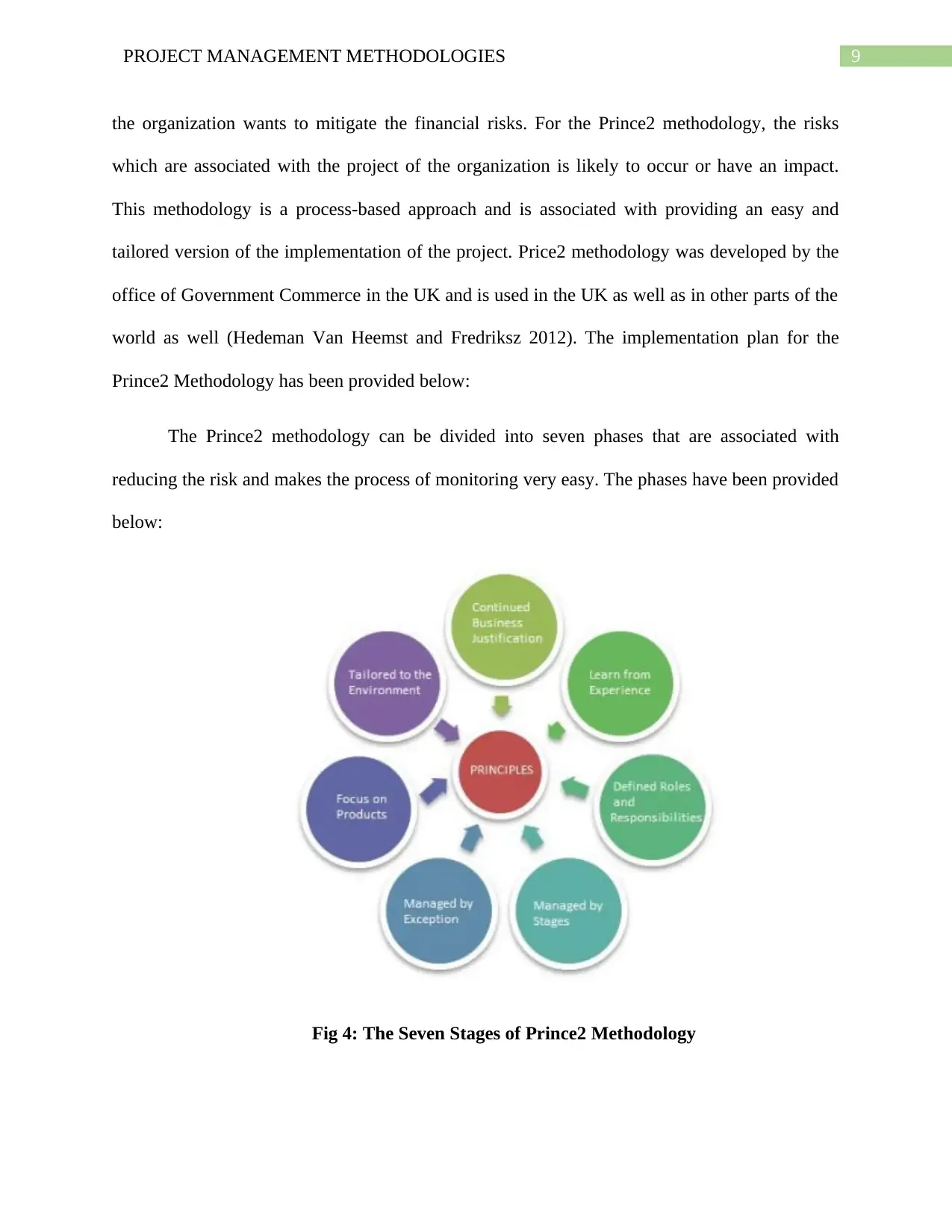
9PROJECT MANAGEMENT METHODOLOGIES
the organization wants to mitigate the financial risks. For the Prince2 methodology, the risks
which are associated with the project of the organization is likely to occur or have an impact.
This methodology is a process-based approach and is associated with providing an easy and
tailored version of the implementation of the project. Price2 methodology was developed by the
office of Government Commerce in the UK and is used in the UK as well as in other parts of the
world as well (Hedeman Van Heemst and Fredriksz 2012). The implementation plan for the
Prince2 Methodology has been provided below:
The Prince2 methodology can be divided into seven phases that are associated with
reducing the risk and makes the process of monitoring very easy. The phases have been provided
below:
Fig 4: The Seven Stages of Prince2 Methodology
the organization wants to mitigate the financial risks. For the Prince2 methodology, the risks
which are associated with the project of the organization is likely to occur or have an impact.
This methodology is a process-based approach and is associated with providing an easy and
tailored version of the implementation of the project. Price2 methodology was developed by the
office of Government Commerce in the UK and is used in the UK as well as in other parts of the
world as well (Hedeman Van Heemst and Fredriksz 2012). The implementation plan for the
Prince2 Methodology has been provided below:
The Prince2 methodology can be divided into seven phases that are associated with
reducing the risk and makes the process of monitoring very easy. The phases have been provided
below:
Fig 4: The Seven Stages of Prince2 Methodology
⊘ This is a preview!⊘
Do you want full access?
Subscribe today to unlock all pages.

Trusted by 1+ million students worldwide
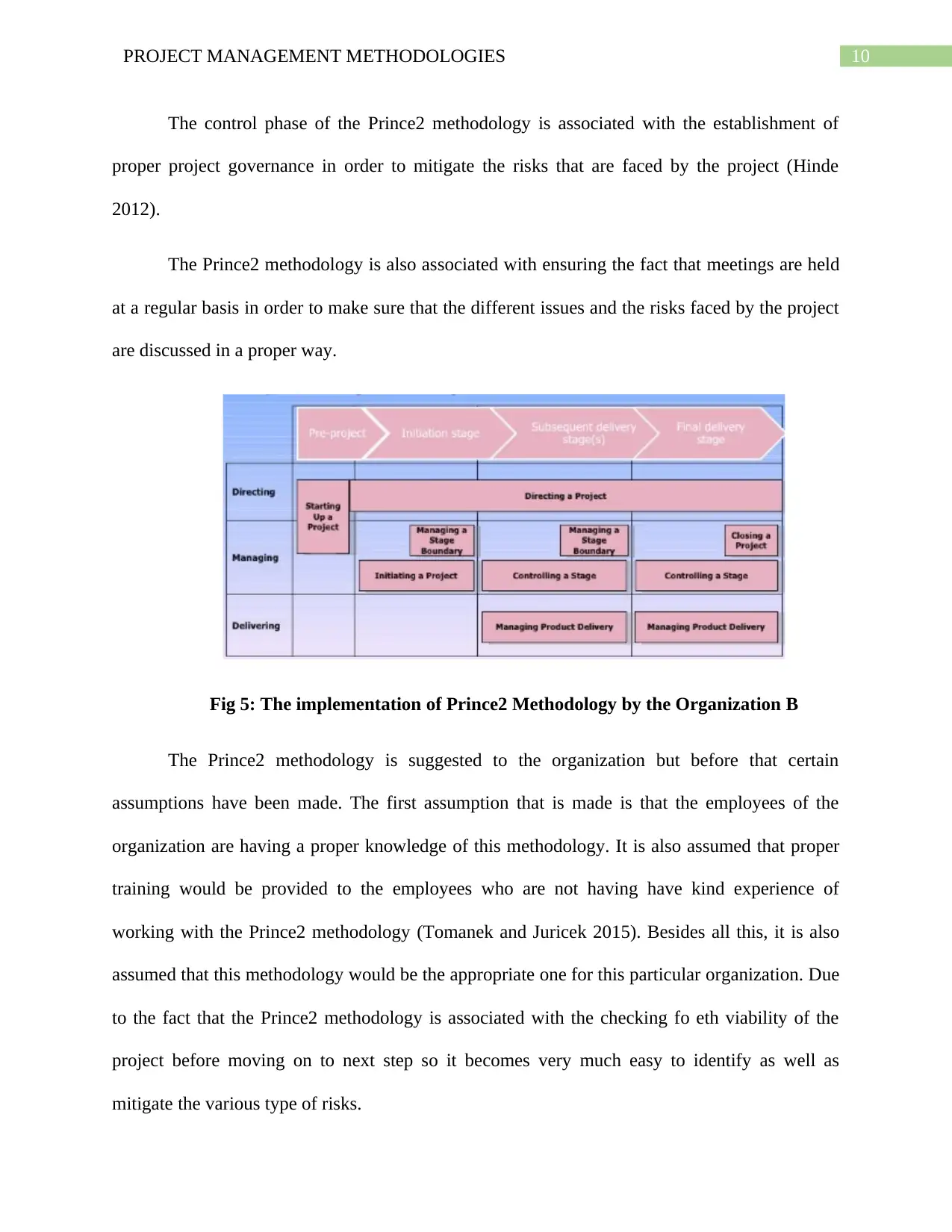
10PROJECT MANAGEMENT METHODOLOGIES
The control phase of the Prince2 methodology is associated with the establishment of
proper project governance in order to mitigate the risks that are faced by the project (Hinde
2012).
The Prince2 methodology is also associated with ensuring the fact that meetings are held
at a regular basis in order to make sure that the different issues and the risks faced by the project
are discussed in a proper way.
Fig 5: The implementation of Prince2 Methodology by the Organization B
The Prince2 methodology is suggested to the organization but before that certain
assumptions have been made. The first assumption that is made is that the employees of the
organization are having a proper knowledge of this methodology. It is also assumed that proper
training would be provided to the employees who are not having have kind experience of
working with the Prince2 methodology (Tomanek and Juricek 2015). Besides all this, it is also
assumed that this methodology would be the appropriate one for this particular organization. Due
to the fact that the Prince2 methodology is associated with the checking fo eth viability of the
project before moving on to next step so it becomes very much easy to identify as well as
mitigate the various type of risks.
The control phase of the Prince2 methodology is associated with the establishment of
proper project governance in order to mitigate the risks that are faced by the project (Hinde
2012).
The Prince2 methodology is also associated with ensuring the fact that meetings are held
at a regular basis in order to make sure that the different issues and the risks faced by the project
are discussed in a proper way.
Fig 5: The implementation of Prince2 Methodology by the Organization B
The Prince2 methodology is suggested to the organization but before that certain
assumptions have been made. The first assumption that is made is that the employees of the
organization are having a proper knowledge of this methodology. It is also assumed that proper
training would be provided to the employees who are not having have kind experience of
working with the Prince2 methodology (Tomanek and Juricek 2015). Besides all this, it is also
assumed that this methodology would be the appropriate one for this particular organization. Due
to the fact that the Prince2 methodology is associated with the checking fo eth viability of the
project before moving on to next step so it becomes very much easy to identify as well as
mitigate the various type of risks.
Paraphrase This Document
Need a fresh take? Get an instant paraphrase of this document with our AI Paraphraser
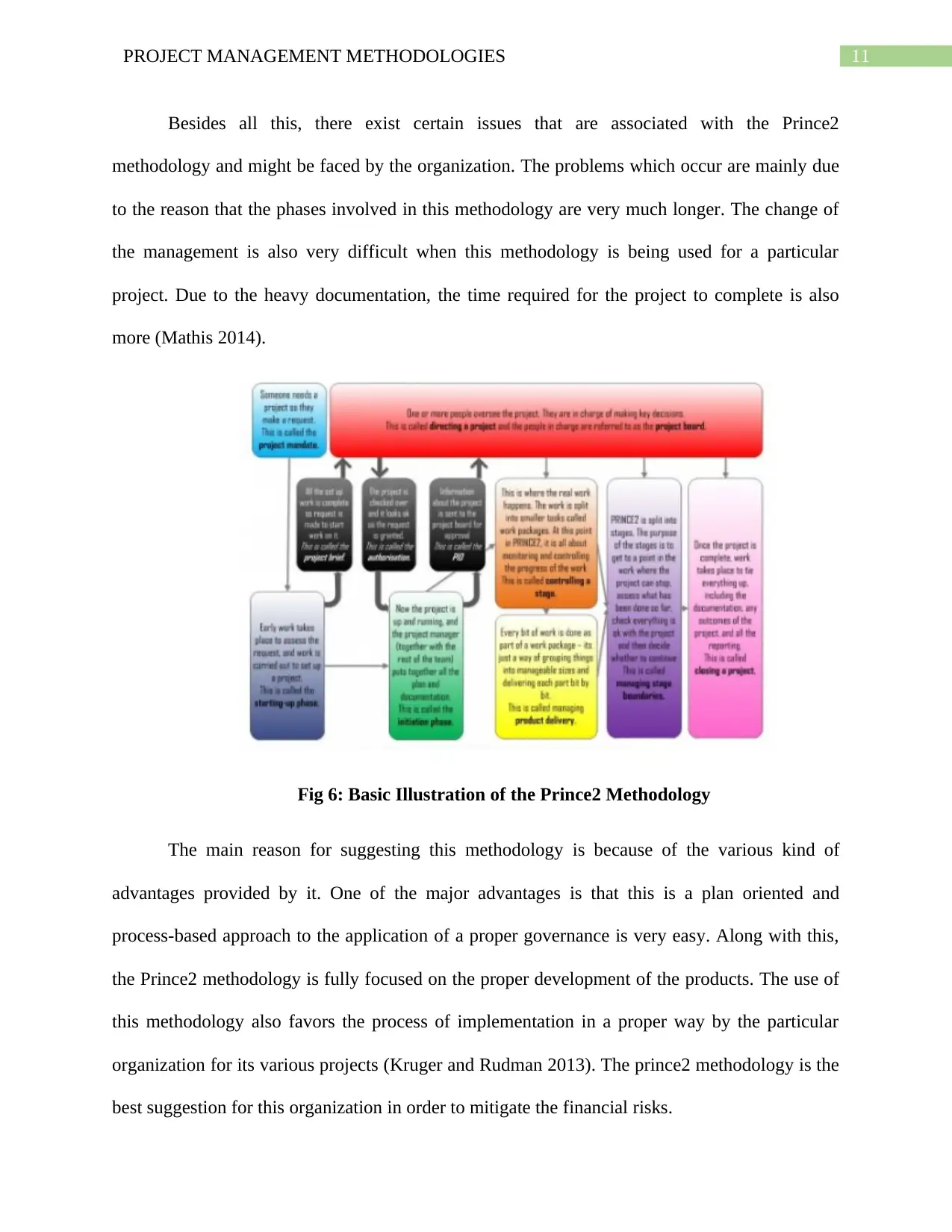
11PROJECT MANAGEMENT METHODOLOGIES
Besides all this, there exist certain issues that are associated with the Prince2
methodology and might be faced by the organization. The problems which occur are mainly due
to the reason that the phases involved in this methodology are very much longer. The change of
the management is also very difficult when this methodology is being used for a particular
project. Due to the heavy documentation, the time required for the project to complete is also
more (Mathis 2014).
Fig 6: Basic Illustration of the Prince2 Methodology
The main reason for suggesting this methodology is because of the various kind of
advantages provided by it. One of the major advantages is that this is a plan oriented and
process-based approach to the application of a proper governance is very easy. Along with this,
the Prince2 methodology is fully focused on the proper development of the products. The use of
this methodology also favors the process of implementation in a proper way by the particular
organization for its various projects (Kruger and Rudman 2013). The prince2 methodology is the
best suggestion for this organization in order to mitigate the financial risks.
Besides all this, there exist certain issues that are associated with the Prince2
methodology and might be faced by the organization. The problems which occur are mainly due
to the reason that the phases involved in this methodology are very much longer. The change of
the management is also very difficult when this methodology is being used for a particular
project. Due to the heavy documentation, the time required for the project to complete is also
more (Mathis 2014).
Fig 6: Basic Illustration of the Prince2 Methodology
The main reason for suggesting this methodology is because of the various kind of
advantages provided by it. One of the major advantages is that this is a plan oriented and
process-based approach to the application of a proper governance is very easy. Along with this,
the Prince2 methodology is fully focused on the proper development of the products. The use of
this methodology also favors the process of implementation in a proper way by the particular
organization for its various projects (Kruger and Rudman 2013). The prince2 methodology is the
best suggestion for this organization in order to mitigate the financial risks.
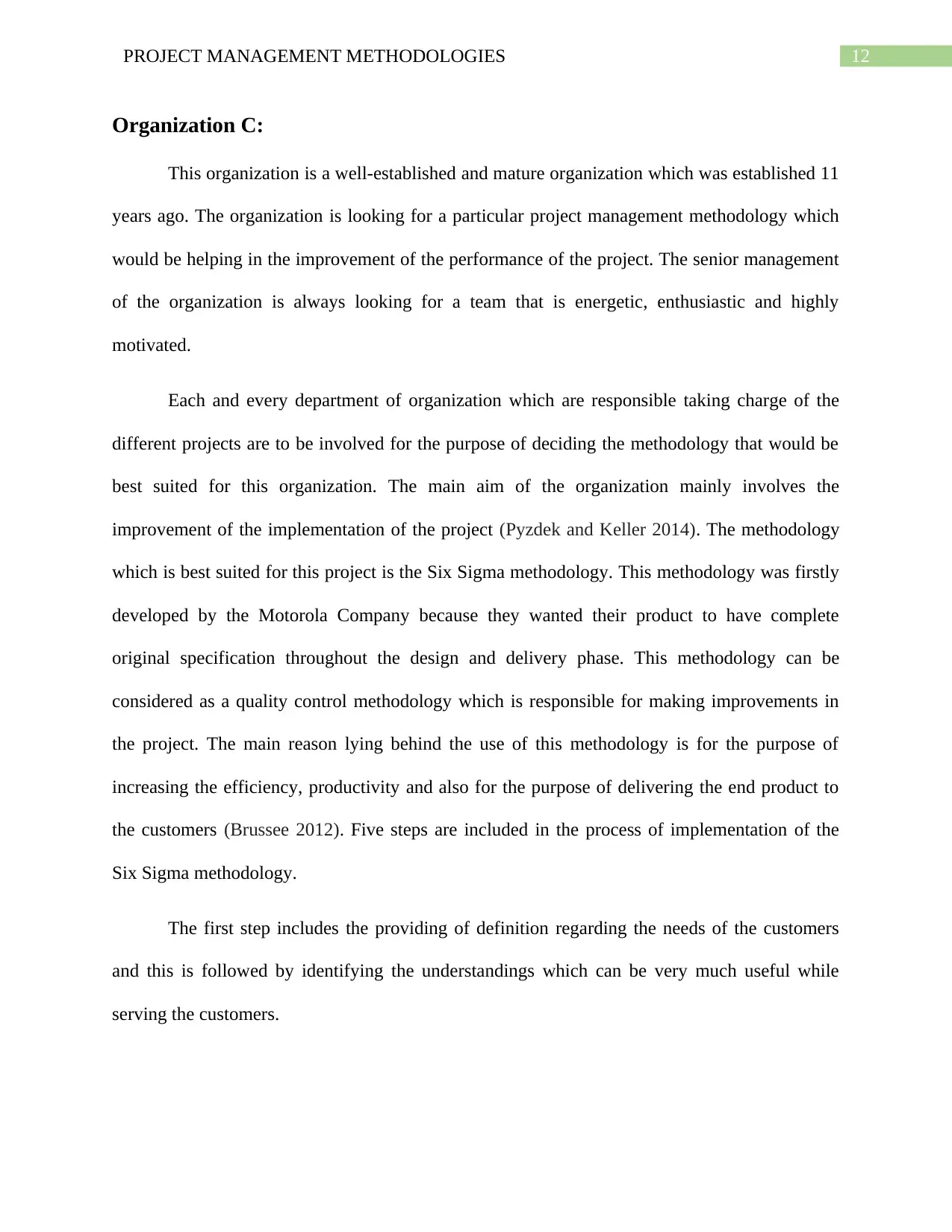
12PROJECT MANAGEMENT METHODOLOGIES
Organization C:
This organization is a well-established and mature organization which was established 11
years ago. The organization is looking for a particular project management methodology which
would be helping in the improvement of the performance of the project. The senior management
of the organization is always looking for a team that is energetic, enthusiastic and highly
motivated.
Each and every department of organization which are responsible taking charge of the
different projects are to be involved for the purpose of deciding the methodology that would be
best suited for this organization. The main aim of the organization mainly involves the
improvement of the implementation of the project (Pyzdek and Keller 2014). The methodology
which is best suited for this project is the Six Sigma methodology. This methodology was firstly
developed by the Motorola Company because they wanted their product to have complete
original specification throughout the design and delivery phase. This methodology can be
considered as a quality control methodology which is responsible for making improvements in
the project. The main reason lying behind the use of this methodology is for the purpose of
increasing the efficiency, productivity and also for the purpose of delivering the end product to
the customers (Brussee 2012). Five steps are included in the process of implementation of the
Six Sigma methodology.
The first step includes the providing of definition regarding the needs of the customers
and this is followed by identifying the understandings which can be very much useful while
serving the customers.
Organization C:
This organization is a well-established and mature organization which was established 11
years ago. The organization is looking for a particular project management methodology which
would be helping in the improvement of the performance of the project. The senior management
of the organization is always looking for a team that is energetic, enthusiastic and highly
motivated.
Each and every department of organization which are responsible taking charge of the
different projects are to be involved for the purpose of deciding the methodology that would be
best suited for this organization. The main aim of the organization mainly involves the
improvement of the implementation of the project (Pyzdek and Keller 2014). The methodology
which is best suited for this project is the Six Sigma methodology. This methodology was firstly
developed by the Motorola Company because they wanted their product to have complete
original specification throughout the design and delivery phase. This methodology can be
considered as a quality control methodology which is responsible for making improvements in
the project. The main reason lying behind the use of this methodology is for the purpose of
increasing the efficiency, productivity and also for the purpose of delivering the end product to
the customers (Brussee 2012). Five steps are included in the process of implementation of the
Six Sigma methodology.
The first step includes the providing of definition regarding the needs of the customers
and this is followed by identifying the understandings which can be very much useful while
serving the customers.
⊘ This is a preview!⊘
Do you want full access?
Subscribe today to unlock all pages.

Trusted by 1+ million students worldwide
1 out of 18
Related Documents
Your All-in-One AI-Powered Toolkit for Academic Success.
+13062052269
info@desklib.com
Available 24*7 on WhatsApp / Email
![[object Object]](/_next/static/media/star-bottom.7253800d.svg)
Unlock your academic potential
Copyright © 2020–2025 A2Z Services. All Rights Reserved. Developed and managed by ZUCOL.




